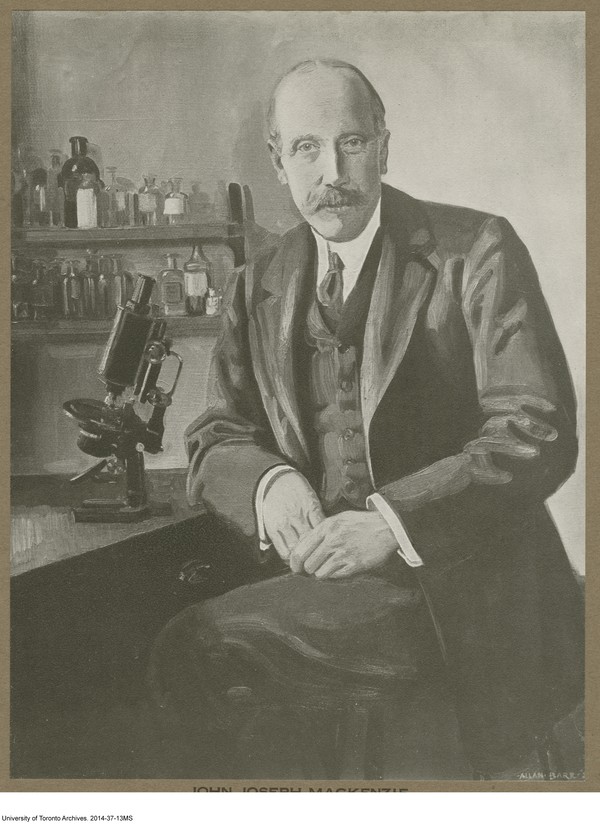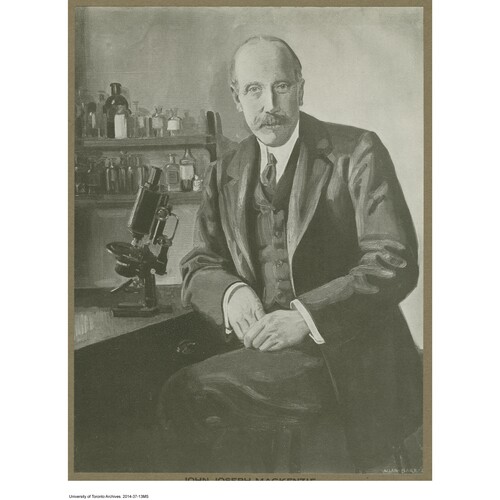
Source: Link
MACKENZIE, JOHN JOSEPH, scientist, civil servant, professor, and army officer; b. 24 March 1865 in St Thomas, Upper Canada, son of Donald Kennedy Mackenzie, a merchant, and Mary McAdam; m. 2 June 1892 Agnes Kathleen Rogers in Toronto; they had no children; d. 1 Aug. 1922 in Gravenhurst, Ont.
Of Scottish parentage, John J. Mackenzie was educated at St Thomas Collegiate Institute. Through “great sacrifice” by his father, in 1882 he entered University College in Toronto, where he soon came “under the spell” of science in the biology lectures of Robert Ramsay Wright*. Among the first to graduate from Wright’s honours program in natural sciences at the University of Toronto, in 1886, Mackenzie contemplated a career in that field at a time when the “scientific point of view had not begun to prevail.”
On the advice of Professor Archibald Byron Macallum*, he went to Germany for graduate work. He studied physiology at the University of Leipzig and bacteriology at the University of Berlin. Because there was little funding for biological research in Ontario, Mackenzie, at the urging of his instructors in Toronto, had also studied anatomy at Leipzig in preparation for a medical degree, “to provide him with the choice of an alternative career.” Of note, in light of his future work, were his biological studies at Berlin, particularly his research in bacteriology at the Koch Institute. While in Europe he also developed a mastery of French and German, which allowed him, Ramsay Wright observed, to acquire an “extensive knowledge of modern pathology.”
Mackenzie returned to Toronto in 1888. After completing a two-year fellowship in biology at the university, he faced the harsh reality of trying to earn a living from research. His wife later wrote that, having no interest in practising medicine but “wishing to marry,” he was “forced” in 1890 to accept a position with the Ontario public service, as first bacteriologist of the Provincial Board of Health [see John Joseph Cassidy*]. The appointment put him in the midst of a small band of public-health reformers who, armed with the germ theory of disease and the microscope, would struggle for decades against political and public indifference. Mackenzie’s laboratory – the second such facility in Canada, the first having been established in Quebec in 1887 [see Wyatt Galt Johnston*] – was located in the board’s offices above a store on Yonge Street; in 1893 it moved to the university. The cost of operating the laboratory came from an appropriation in the Department of Agriculture for the investigation of diseases in animals. With obvious frustration, Mackenzie later noted that it was “easier to get legislation to expend money upon animal husbandry than upon the protection of human life.”
Mackenzie faced a formidable task. By 1897 he was trying, in the words of board secretary Peter Henderson Bryce*, to undertake “work for almost all the 800 municipalities in a province of 2,250,000.” Consequently, it was impossible for the laboratory “to do more than touch the fringe of the routine practical work” in the face, that year, of 10,000 cases of diphtheria, 5,000 or more of tuberculosis, and 1,432 of typhoid. Overwhelmed, Mackenzie did almost everything, from preparing media and solutions to examining thousands of specimens under his microscope. Still, over the course of this heavily repetitive work, he initiated many procedures, such as diphtheria swabs and the tuberculin testing of cattle. In addition, his systematic bacteriological and chemical examination of human and municipal-water samples, for evidence of tuberculosis and typhoid, was copied by other governmental laboratories in North America.
Despite the monotony, Mackenzie’s scientific curiosity remained active, and it produced some impressive results. For instance, in 1894 he was an early observer of the degenerative impact of rabies on nerve-cell tissue: “I saw the structures afterwards described as ‘Negri bodies’ in the brains of rabbits dying from rabies, in dogs and in the brain of a child who had died of rabies in Hamilton.” He also used his laboratory to study infectious micro-organisms, especially those causing diphtheria. More than just a researcher, Mackenzie advocated the use of diphtheria antitoxin and in 1895 he imported a supply from the Institut Pasteur in Paris for distribution to doctors treating children. This action, his wife recalled, “gained him some abuse” from critics of the use on humans of biological products from animals.
Mackenzie’s “growing discontent” with his job gradually led to his return to the university. While working at the laboratory, he also taught, for the Royal College of Dental Surgeons of Ontario and the faculty of medicine, and studied medicine at night. He received his mb from the university in 1899. On 23 July 1900 he resigned his provincial position and joined the faculty as professor of pathology and bacteriology. Here his career as a researcher blossomed. His goal was simple – “to make pathology a bridge between clinic and laboratory” – and he firmly believed in research in hospitals. He approached, he once said in an address, the “disease phenomena from the broader biological standpoint, in contrast to the older methods of viewing them from the narrow aspect of human pathological anatomy.” Elected in 1909 a fellow of the Royal Society of Canada and president of the Canadian Institute, he belonged to numerous scientific bodies, among them the Canadian Public Health Association, the American Association of Pathologists and Bacteriologists, and the Pathological Society of Great Britain and Ireland. In 1912–16 he and a colleague, Thomas Gregor Brodie, investigated the physiology and histology of the kidney; a portion of their work was published in the Proceedings of the Royal Society of London. In total Mackenzie published over 30 papers based on his own research. Among those who knew this tall (six feet, six inches), somewhat reserved authority, he was distinguished too by his “charming personality,” “wide culture,” and enthusiasm for golf and travel.
During World War I Mackenzie joined No.4 Canadian General Hospital, becoming a captain in April 1915 and head of its laboratory. Staffed largely from Toronto’s hospitals and the university, the unit went overseas the following month. From November to August 1916 Mackenzie served with it at Salonica (Thessaloniki), Greece, where his work on severe dysentery led to improved treatment. Exposed to taxing field conditions, he contracted a heart infection that stayed with him when he returned to teaching in Toronto. In 1922 he died in Muskoka, where he and his wife summered, and was buried in Lakeview Cemetery in Gravenhurst.
John Joseph Mackenzie’s publications include “A preliminary list of algae collected in the neighbourhood of Toronto,” Canadian Institute, Proc. (Toronto), 7 (1889–90): 270–74; “A case of acute phlegmonous gastritis,” Canada Lancet (Toronto), 40 (1906–7): 491–94; “Ultramicroscopic organisms” and “Presidential address: human evolution and human disease,” Canadian Institute, Trans., 8 (1904–9): 53—62 and 535–47; and “Chairman’s address,” Public Health Journal (Toronto), 10 (1919): 265–69. A report on his research with T. G. Brodie appears under the title “On changes in the glomerules and tubules of the kidney accompanying activity,” in Royal Soc. of London, Proc., ser.B, 87 (1914): 593–609. The best summary of Mackenzie’s annual work for the Provincial Board of Health is found in his “Report of the laboratory work for the board for 1899,” in its Annual report (Toronto), 1899: 29–32 (also published in Ont., Legislature, Sessional papers, 1900, no.32).
Mackenzie’s wartime letters were published posthumously as Number 4 Canadian Hospital: the letters of Professor J. J. Mackenzie from the Salonika front, with a memoir by his wife, Kathleen Cuffe Mackenzie (Toronto, 1933).
AO, RG 22-305, no.45752; RG 80-5-0-201, no.14508. Univ. of Toronto Arch., A73-0026/279(70). P. A. Bator with A. J. Rhodes, Within reach of everyone: a history of the University School of Hygiene and the Connaught Laboratories (1v. to date, Ottawa, 1990– ). Canadian men and women of the time (Morgan; 1912). A. B. Macallum, “J. J. Mackenzie – an appreciation,” Univ. of Toronto Monthly, 23 (1922–23): 8. J. W. S. McCullough, “Early history of public health in Upper and Lower Canada,” Canadian Journal of Medicine and Surgery (Toronto), 51 (January–June 1922): 60–84. Ont., Provincial Board of Health, Annual report, 1890–1900. RSC, Trans., 3rd ser., 17 (1923), proc.: iv–vii.
Cite This Article
Paul Adolphus Bator, “MACKENZIE, JOHN JOSEPH,” in Dictionary of Canadian Biography, vol. 15, University of Toronto/Université Laval, 2003–, accessed December 28, 2025, https://www.biographi.ca/en/bio/mackenzie_john_joseph_15E.html.
The citation above shows the format for footnotes and endnotes according to the Chicago manual of style (16th edition). Information to be used in other citation formats:
| Permalink: | https://www.biographi.ca/en/bio/mackenzie_john_joseph_15E.html |
| Author of Article: | Paul Adolphus Bator |
| Title of Article: | MACKENZIE, JOHN JOSEPH |
| Publication Name: | Dictionary of Canadian Biography, vol. 15 |
| Publisher: | University of Toronto/Université Laval |
| Year of publication: | 2005 |
| Year of revision: | 2005 |
| Access Date: | December 28, 2025 |



